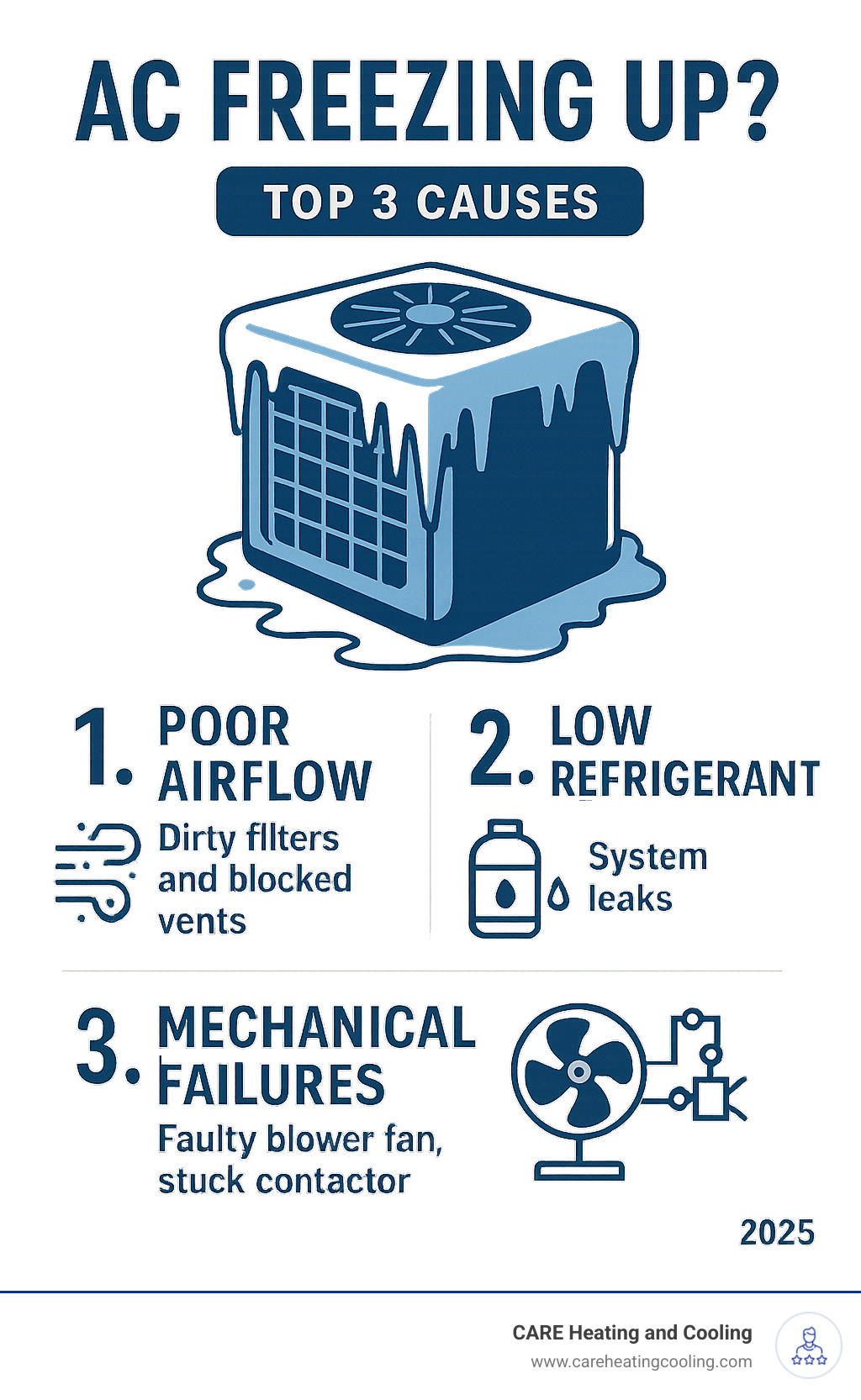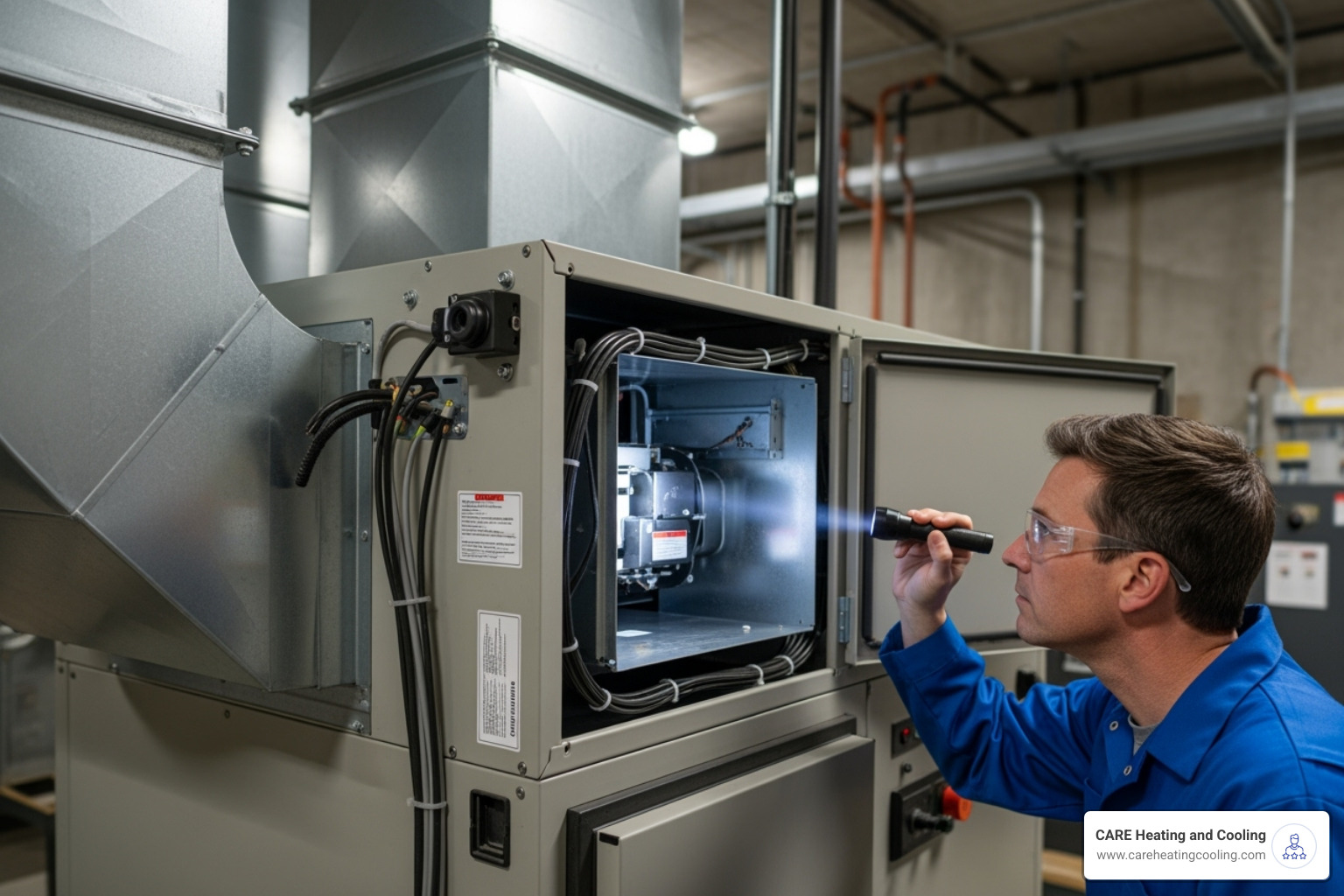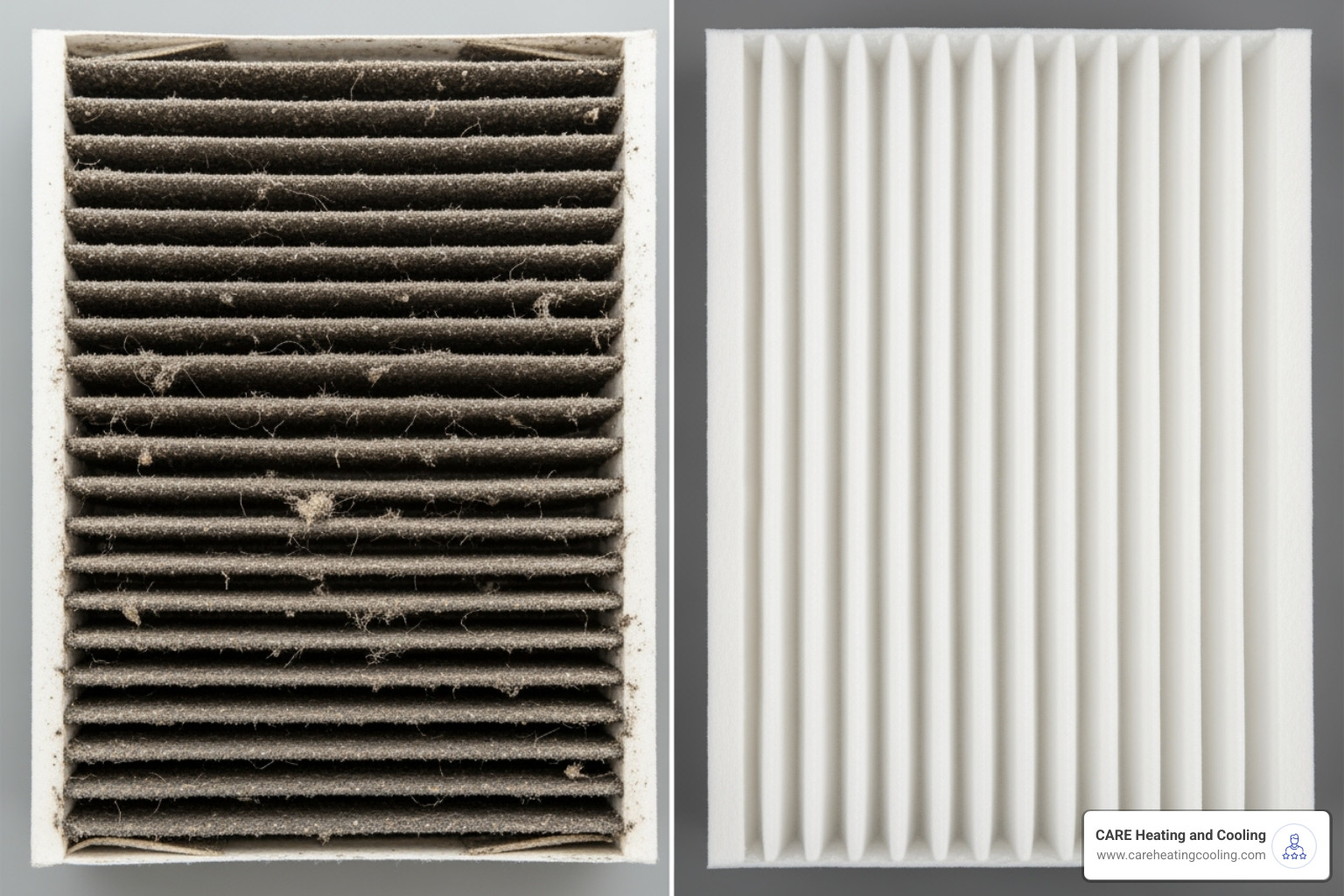When Your AC Turns Into an Ice Block: Understanding Frozen Air Conditioners
AC freezing up might sound impossible when it’s 90 degrees outside, but it’s actually one of the most common air conditioning problems homeowners face during summer. When your AC freezes, you’ll notice these key warning signs:
- Visible ice on the refrigerant lines or evaporator coil
- Warm air blowing from your vents instead of cool air
- Water puddles around your indoor unit from melting ice
- Reduced airflow from supply registers
- Poor cooling performance throughout your home
The main culprits behind a frozen AC are poor airflow (usually from dirty filters), low refrigerant levels due to leaks, and mechanical failures like a faulty blower fan. While some causes have simple DIY fixes, others require professional repair to prevent expensive compressor damage.
Research shows that two-thirds of all homes in the United States have air conditioning systems, and changing your HVAC filter alone can improve efficiency by 5% to 15%. The good news? Most frozen AC problems are preventable with regular maintenance.
If your AC is currently frozen, turn off the cooling mode immediately and switch the fan to “on” to help it thaw. Never try to chip away ice or force the system to run while frozen – this can cause thousands of dollars in damage to your compressor.
How to Spot a Frozen AC Unit
When your air conditioner decides to turn into an ice maker instead of a cooling machine, it usually gives you some pretty clear warning signs. The trick is knowing what to look for so you can catch the problem before it becomes a costly repair.
The most obvious clue is visible ice forming on your system’s components. You’ll typically spot this ice on the evaporator coil inside your indoor air handler or on the large, insulated refrigerant line (called the suction line) that connects your outdoor and indoor units. If you see ice building up on that frozen refrigerant line, there’s a good chance your indoor evaporator coil is also frozen solid.
Here’s where it gets a bit confusing: while you might notice some issues near your outdoor condenser unit, the real problem usually starts with your indoor evaporator coil. Think of it like this – the evaporator coil is where the actual cooling magic happens, so when it freezes, everything else starts going haywire.
Another dead giveaway is warm air blowing from your vents when you’re expecting that refreshing cool breeze. When AC freezing up occurs, the ice-covered coil can’t do its job of absorbing heat from your home’s air. It’s like trying to cool down with a blanket wrapped around your fan – not very effective.
You might also find water damage near your indoor unit or mysterious puddles appearing on your floor. As the ice melts, it can overwhelm the condensate drain pan, causing water to spill over. That steady dripping sound isn’t just annoying – it’s your AC crying for help.
Finally, you’ll notice weak airflow from vents and your home just won’t reach that comfortable temperature you’ve set on your thermostat. The ice acts like a wall, blocking air from flowing over the coil properly. When your AC isn’t cooling properly, a frozen coil is often the sneaky culprit behind your discomfort.
If you’re dealing with cooling problems and want to dig deeper into the causes, you can find more info about why your AC isn’t cooling your home the way it should.
Why is My AC Freezing Up? The Most Common Causes
When your AC freezing up turns your cooling system into an unwelcome ice sculpture, it’s usually because something has disrupted the delicate balance your air conditioner needs to work properly. Your AC doesn’t actually create cold air – it removes heat from inside your home and moves it outside. This process depends on the right amount of airflow, proper refrigerant pressure, and all the mechanical parts working together smoothly.
Think of your evaporator coil (the part inside your home) like a sponge that soaks up heat from the air. When warm air flows over this cold coil, the heat gets absorbed and moisture condenses on the coil’s surface. But if something goes wrong and the coil gets too cold, that moisture turns into ice instead. Let’s walk through the most common reasons this happens, starting with the simple fixes you might be able to handle yourself.
Poor Airflow: The #1 Culprit
By far, the most common reason we see for an AC freezing up is poor airflow across the evaporator coil. Your coil needs a steady stream of warm air flowing over it to stay at the right temperature. When that warm air can’t reach the coil, it’s like leaving an ice cube in the freezer too long – it just keeps getting colder until everything around it freezes.
Dirty air filters cause more frozen ACs than any other single problem. When your filter gets clogged with dust, pet hair, and debris, it’s like trying to breathe through a pillow. The air simply can’t get through to reach the coil. Without that warm air, the coil drops below freezing and starts collecting ice. We always tell our customers that changing your HVAC filter can improve efficiency by 5% to 15%, and it’s the easiest way to prevent freezing problems.
Blocked vents and registers create the same problem as dirty filters. We’ve seen everything from furniture pushed against vents to kids’ toys stuffed into return air grilles. Some homeowners think they’re saving energy by closing vents in unused rooms, but this actually makes your system work harder and increases the risk of freezing. Your AC was designed to move a specific amount of air, and when you block that airflow, problems start.
Obstructed return air ducts prevent your system from pulling enough warm air back to the air handler. These ducts are like the “inhale” part of your AC’s breathing – they need to be clear to bring warm air from your home back to the coil. When they’re blocked or too small, your system can’t get the airflow it needs.
Even with clean filters, your evaporator coil itself can get dirty over time. This layer of grime acts like a winter coat on the coil, preventing it from properly absorbing heat from the air. When the coil can’t do its job of heat absorption, it gets too cold and ice starts forming.
How Low Refrigerant Levels Lead to AC Freezing Up
Your AC system uses refrigerant in a closed loop – like the coolant in your car’s radiator. It should never run low unless there’s a leak somewhere in the system. When refrigerant levels drop, the pressure inside your evaporator coil drops too. This causes the refrigerant to expand more than it should, making the coil extremely cold through what’s called the Joule-Thomson Effect.
Refrigerant leak signs include hissing or bubbling sounds coming from your outdoor unit or the refrigerant lines. You might also notice an oily residue around the connections, since refrigerant contains lubricant for the compressor. Most obviously, your home won’t cool down properly even though the system seems to be running. If you suspect a leak, don’t try to fix it yourself – refrigerant requires special handling and equipment. You can learn the signs of refrigerant leaks to know when to call for help.
The type of refrigerant in your system matters too. R22 vs. R410A refrigerant represents old versus new technology. If your system uses R22 (typically installed before 2010), you’re dealing with a refrigerant that’s being phased out and has become very expensive. R410A is the current standard – it’s better for the environment, more efficient, and much more affordable to service.
| Feature | R22 (Freon) | R410A (Puron) |
|---|---|---|
| Status | Phased out, expensive, limited availability | Current industry standard, readily available |
| Environmental | High Ozone Depletion Potential (ODP) | Zero ODP, more environmentally friendly |
| Pressure | Lower operating pressures | Higher operating pressures |
| System Design | Older systems, less efficient | Newer systems, typically more efficient |
| Repair Cost | Higher due to refrigerant cost and scarcity | Lower due to refrigerant availability |
Mechanical and Component Failures
Sometimes the problem isn’t airflow or refrigerant – it’s a mechanical part that’s given up the ghost. Your blower fan is responsible for moving air across the evaporator coil and through your home. When this fan isn’t working properly, you get the same result as a dirty filter: not enough warm air reaching the coil.
A malfunctioning fan motor might seem to be running but not moving enough air, or it might stop working entirely. Either way, your AC will quickly turn into a block of ice. If you notice your AC fan keeps running when the system is off, it could be trying to defrost a frozen coil or signal a deeper problem.
Stuck contactors are electrical switches that turn your compressor on and off. When a contactor gets “welded” in the closed position, your compressor runs constantly, even when it shouldn’t. This non-stop operation can lead to overcooling and eventually a frozen coil.
Other Potential Issues
A few other culprits can contribute to freezing problems. Clogged condensate drain lines might seem unrelated, but when these drains back up with algae or debris, water can overflow and come into contact with the very cold evaporator coil, adding to the ice problem.
Incorrectly sized AC units cause more problems than you might think. A unit that’s too big will cool your home too quickly, shutting off before it has time to remove humidity properly. This leaves excess moisture on the coil that can freeze. A unit that’s too small will run constantly, struggling to keep up and creating its own set of problems.
Finally, running the AC when outdoor temperatures drop below 60°F can cause issues. Most residential air conditioners aren’t designed to work efficiently in cool weather. The refrigerant pressure drops too low, making the evaporator coil get extremely cold and freeze up. On those cool summer nights, you’re better off opening windows and using fans instead of running your AC.
Your AC is a Block of Ice: What to Do Right Now
Finding your AC freezing up on a sweltering summer day feels like finding your refrigerator has decided to become a heater. It’s frustrating, but don’t let panic set in! The good news is that taking the right steps immediately can save you from costly repairs and get you back to comfortable temperatures sooner.
Turn off the cooling at the thermostat right away. This isn’t the time to just bump up the temperature a few degrees – you need to completely switch off the cooling mode to stop the refrigerant flow. Think of it as giving your overwhelmed system a much-needed break. Running a frozen AC is like asking someone to run a marathon with their shoelaces tied together – it’s going to cause damage, and in this case, that damage hits your wallet hard.
Next, switch the fan to ‘ON’ at your thermostat. Change it from ‘AUTO’ to ‘ON’ so the indoor blower fan runs continuously. This circulates warmer air from your home over that frozen evaporator coil, essentially giving it a gentle, warm hug to help it thaw. It’s like using a hair dryer on low heat instead of trying to chisel away ice with a hammer.
Now comes the hardest part: allow the unit to thaw completely. We know waiting is tough when it’s 90 degrees outside, but patience here prevents disaster. Most units need 1 to 3 hours to thaw, though severely iced-up systems might need up to 24 hours. Resist the urge to grab tools and start chipping away at the ice, and definitely don’t pour hot water on the coil. These well-intentioned moves can damage delicate components and turn a simple fix into an expensive repair.
While you’re waiting, check and change the air filter. A dirty filter is often the culprit behind frozen coils, so replacing it now might solve your problem entirely. Also, take a walk through your home to make sure all vents are open and clear of furniture, curtains, or that pile of laundry that somehow migrated to the floor vent.
The long-term consequences of ignoring a frozen AC are serious. Your compressor – the heart of your cooling system – can suffer permanent damage when forced to work against a block of ice. Compressor damage often means costly repairs that can rival the cost of a new system. It’s like continuing to drive a car with a flat tire – you might get where you’re going, but you’ll destroy much more than just the tire in the process.
If your AC has completely given up the ghost, our guide on what to do when your AC stops working can help you troubleshoot the next steps and get back to cool comfort.
How to Prevent Your AC From Freezing Again
Nobody wants to deal with an AC freezing up twice. The good news? Most frozen AC problems are completely preventable with some simple habits and regular care. Think of it like brushing your teeth – a little daily attention prevents big problems down the road.
The key to preventing future freeze-ups is understanding that your AC needs three things to work properly: good airflow, the right amount of refrigerant, and all its parts working smoothly. When any of these gets out of whack, you’re back to square one with ice where there should be cool air.
Key Maintenance Practices to Stop Your AC Freezing Up
The most important thing you can do is change your air filter regularly. We know it sounds simple, but a dirty filter is behind most frozen AC calls we get. Check your filter every month and replace it every 1-3 months, or even more often if you have furry friends or family members with allergies. A clean filter keeps air flowing properly over your evaporator coil, preventing it from getting too cold and turning into an ice sculpture.
Keeping your vents clear is just as crucial. Walk through your home and make sure furniture, curtains, or that pile of laundry isn’t blocking your supply and return vents. We’ve seen beautiful home makeovers that accidentally block airflow, turning a comfortable space into a freezing zone for your AC. All your registers should stay open too – closing them might seem like it saves energy, but it actually creates pressure problems that can lead to freezing.
Your outdoor unit needs breathing room as well. Clear away leaves, grass clippings, and any debris that might be choking your condenser unit. Give it at least two feet of space all around. A clean outdoor unit doesn’t directly prevent your indoor coil from freezing, but it helps your whole system work more efficiently and with less strain.
The most important step is scheduling annual professional tune-ups. During these visits, our technicians clean both your indoor and outdoor coils, check refrigerant levels for leaks, test your blower fan and motor, clear your condensate drain line, and inspect all the electrical connections. We catch small issues before they become big, expensive problems.
At CARE Heating and Cooling, we’re proud to have earned the BBB Torch Award for Ethics. Our technicians are paid to fix your unit, not to sell you a new one, so you can trust that we’re always looking for the most cost-effective solution for you. Professional maintenance ensures you have proper airflow, the correct refrigerant charge, and healthy mechanical components – everything needed to keep your AC freezing up from happening again.
You can learn more about professional air conditioning service and how it benefits your system’s longevity. We also have specific tips for how to prevent AC freezing in hot weather when your system is working its hardest.
Frequently Asked Questions about Frozen AC Units
When your AC is freezing up, it’s natural to have questions. We hear these concerns from homeowners all the time, and we’re here to help you understand what’s happening with your system.
How long does it take for a frozen AC to thaw?
The thawing time really depends on how much ice has built up on your evaporator coil. For a typical freeze-up with moderate ice formation, you can expect it to take 1 to 3 hours once you’ve turned off the cooling and switched your fan to ‘ON’.
However, if your coil looks like it belongs in Antarctica – completely encased in thick ice – you might be waiting up to 24 hours for everything to melt. We know that’s frustrating when it’s hot outside, but patience is your friend here.
The key is keeping that fan running. It circulates warm air from inside your home over the frozen coil, which speeds up the melting process significantly. Think of it like using a hair dryer on low heat – gentle but effective. Whatever you do, resist the urge to chip away at the ice or pour hot water on it. That’s a recipe for expensive damage to those delicate coil fins.
Can I just add more refrigerant to fix the problem?
This is one of the biggest misconceptions we encounter, and the answer is a firm no. Your air conditioning system operates as a closed loop – refrigerant doesn’t get “used up” like gas in your car. It simply circulates around and around, doing its job of absorbing and releasing heat.
If your refrigerant levels are low, it means there’s a leak somewhere in your system. Adding more refrigerant without fixing that leak is like filling a bucket with a hole in the bottom – it’s wasteful, temporary, and you’ll be right back where you started.
More importantly, handling refrigerant isn’t a DIY job. It requires special certification and equipment due to environmental regulations and safety concerns. A certified technician will properly diagnose the leak, repair it, and then recharge your system to the exact specifications your manufacturer requires. This is the only way to truly solve a refrigerant-related freezing problem.
Is it safe to run my AC if it keeps freezing?
Absolutely not, and here’s why this matters so much for your wallet. While one freeze-up that you handle properly might not cause lasting damage, repeatedly running a frozen AC is like driving your car with the parking brake on – something’s going to break, and it won’t be cheap.
The biggest risk is damage to your compressor, which is essentially the heart of your entire AC system. When your evaporator coil is frozen solid, your compressor has to work incredibly hard to try to move refrigerant through the system. This excessive strain can cause it to overheat and eventually burn out completely.
Replacing a compressor is often the most expensive repair your AC can need. In many cases, it costs so much that homeowners decide to replace the entire system instead. That’s why we always tell our customers: if your AC keeps freezing up even after you’ve tried the basic troubleshooting steps, it’s time to call in a professional. The money you spend on a proper diagnosis and repair will be a fraction of what you’d pay for a new compressor or entire system.
When to Call a Professional for Your Frozen AC
Sometimes, despite your best efforts with the basics, your AC freezing up becomes a stubborn problem that just won’t quit. While we love empowering homeowners with DIY knowledge, there comes a point where professional expertise is the smartest and safest route forward.
When your DIY fixes don’t work, it’s time to call in the cavalry. You’ve done everything right – changed the filter, cleared the vents, let the unit thaw completely – but your AC decides to turn into an ice sculpture again within hours or days of restarting. This persistent freezing tells us there’s a deeper issue lurking beneath the surface that requires professional diagnostic tools and expertise to uncover.
If ice returns after thawing, even after you’ve addressed the obvious culprits, you’re likely dealing with a refrigerant leak, a failing mechanical component, or an airflow problem that’s not immediately visible. These issues can be tricky to diagnose without specialized equipment and years of experience troubleshooting HVAC systems.
Refrigerant leaks are definitely professional territory. If you suspect a leak – whether you hear those telltale hissing or bubbling sounds, notice oily residue around your unit, or your AC just isn’t cooling like it used to – please don’t attempt a DIY repair. Refrigerant handling requires special certification, and improper handling can be dangerous to both you and the environment. Plus, simply adding more refrigerant without fixing the actual leak is like putting a band-aid on a broken pipe.
Unusual noises from your AC are another red flag that shouldn’t be ignored. Banging, clanking, buzzing, or grinding sounds often signal mechanical failures like a dying blower motor, loose components, or worn bearings. These problems don’t just contribute to freezing – they can lead to complete system failure if left unchecked.
At CARE Heating and Cooling, we’ve built our reputation on doing right by our customers. We’re proud recipients of the BBB Torch Award for Ethics, which reflects our commitment to honest, transparent service. Here’s what makes us different: our technicians are paid to fix units, not sell new ones. This means when we come to your home, our only goal is finding the most cost-effective solution for your specific situation, whether that’s a simple repair or honest advice about replacement options.
We understand that calling for professional help can feel daunting, especially when you’re worried about costs. That’s why we focus on customer-centric solutions that prioritize your comfort and budget. Our team will thoroughly diagnose the problem, explain what’s happening in plain English, and give you options that make sense for your home and wallet.
Don’t let a frozen AC turn your summer into a sweaty nightmare or lead to expensive compressor damage down the road. If you’re dealing with persistent freezing or any of the warning signs we’ve discussed, we’re here to help. You can easily schedule your AC repair with our trusted technicians and get back to enjoying reliable, cool comfort in your home.











